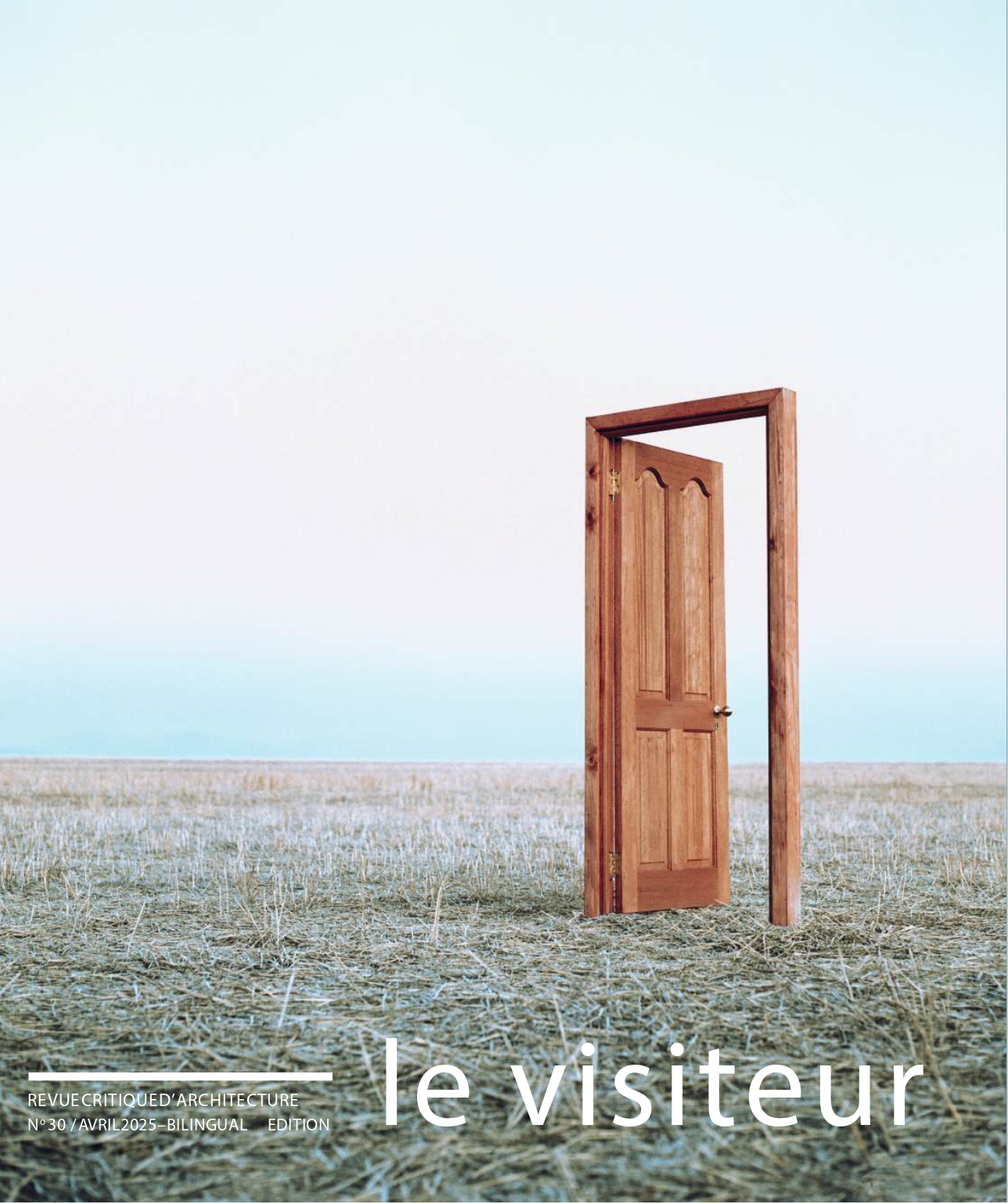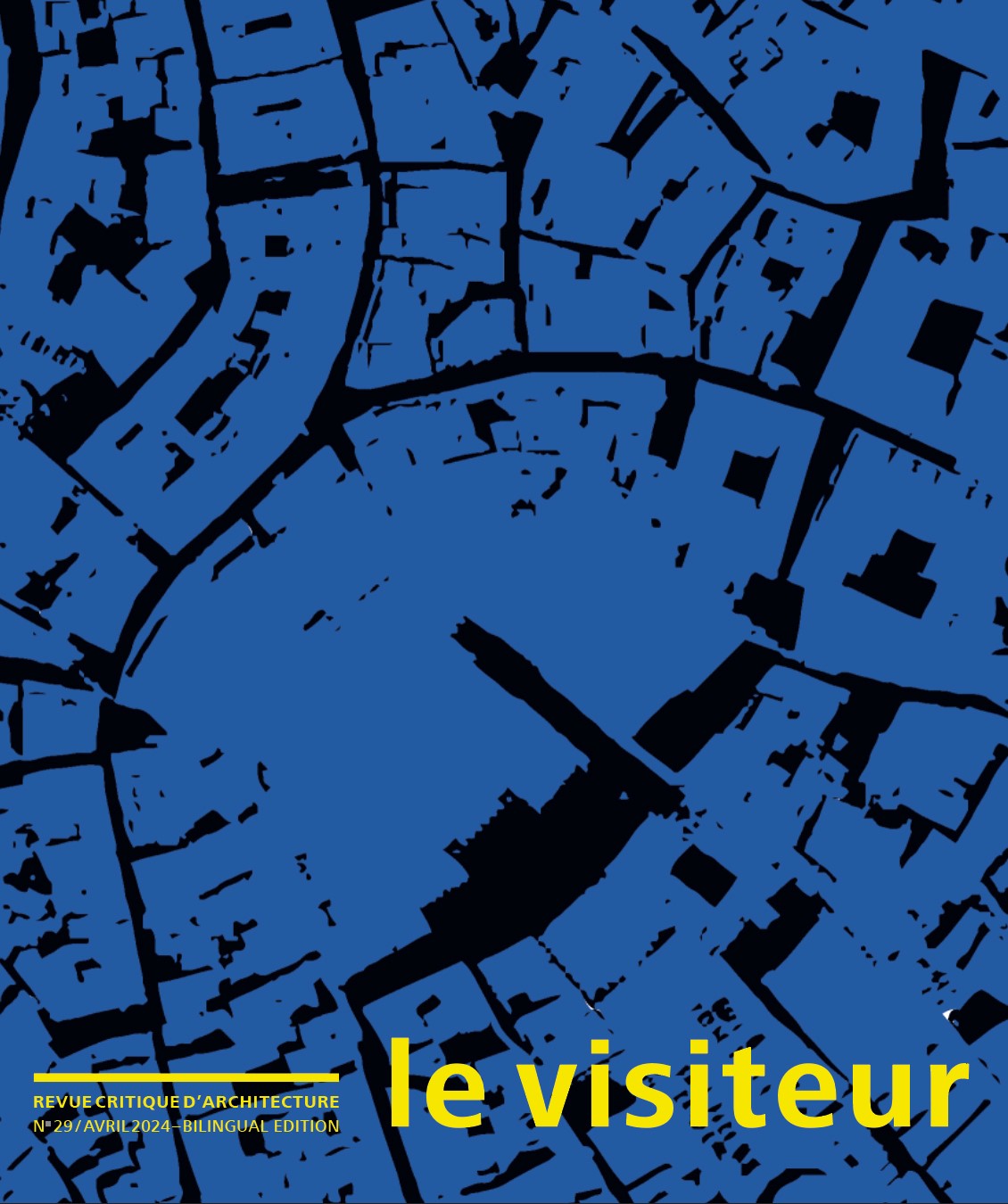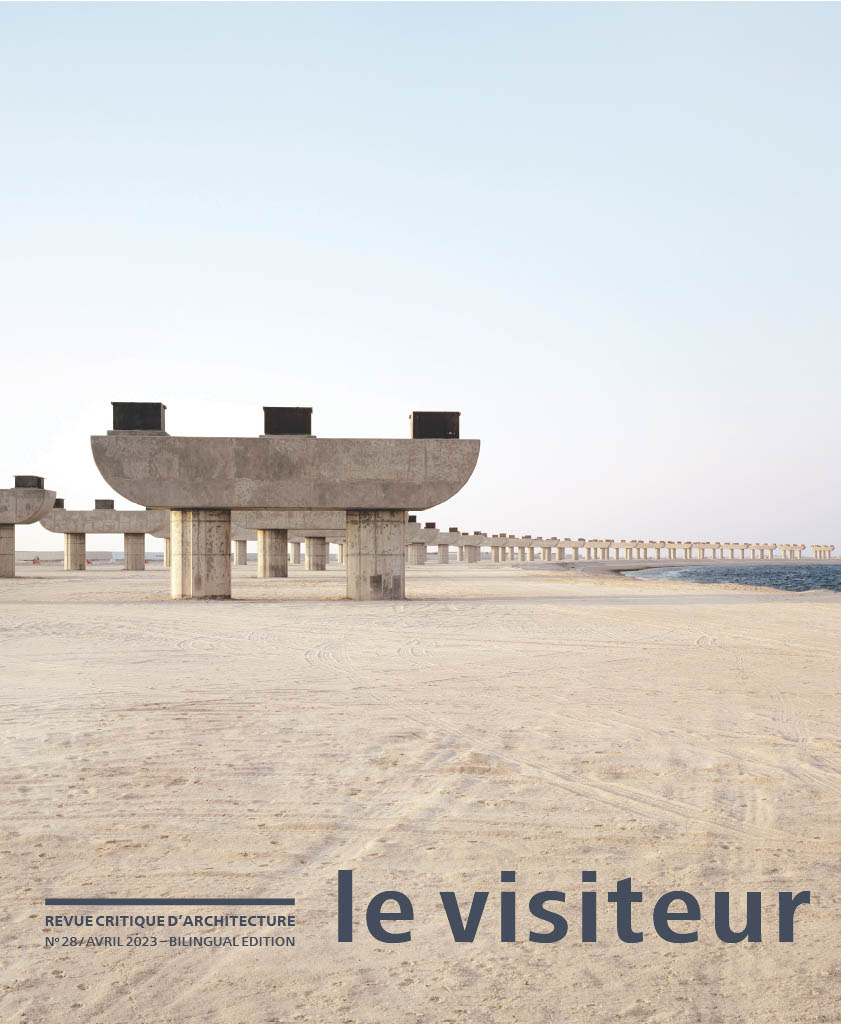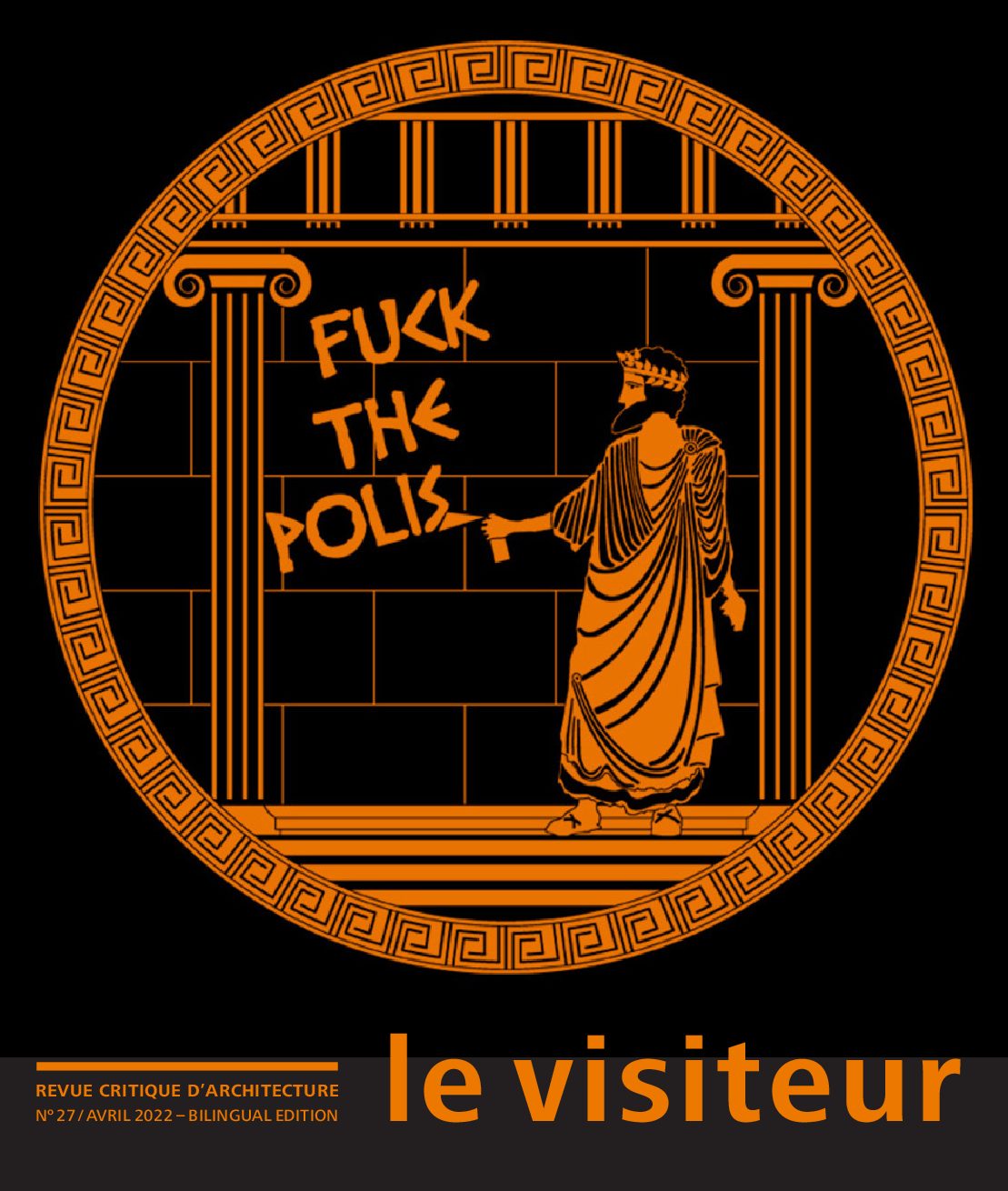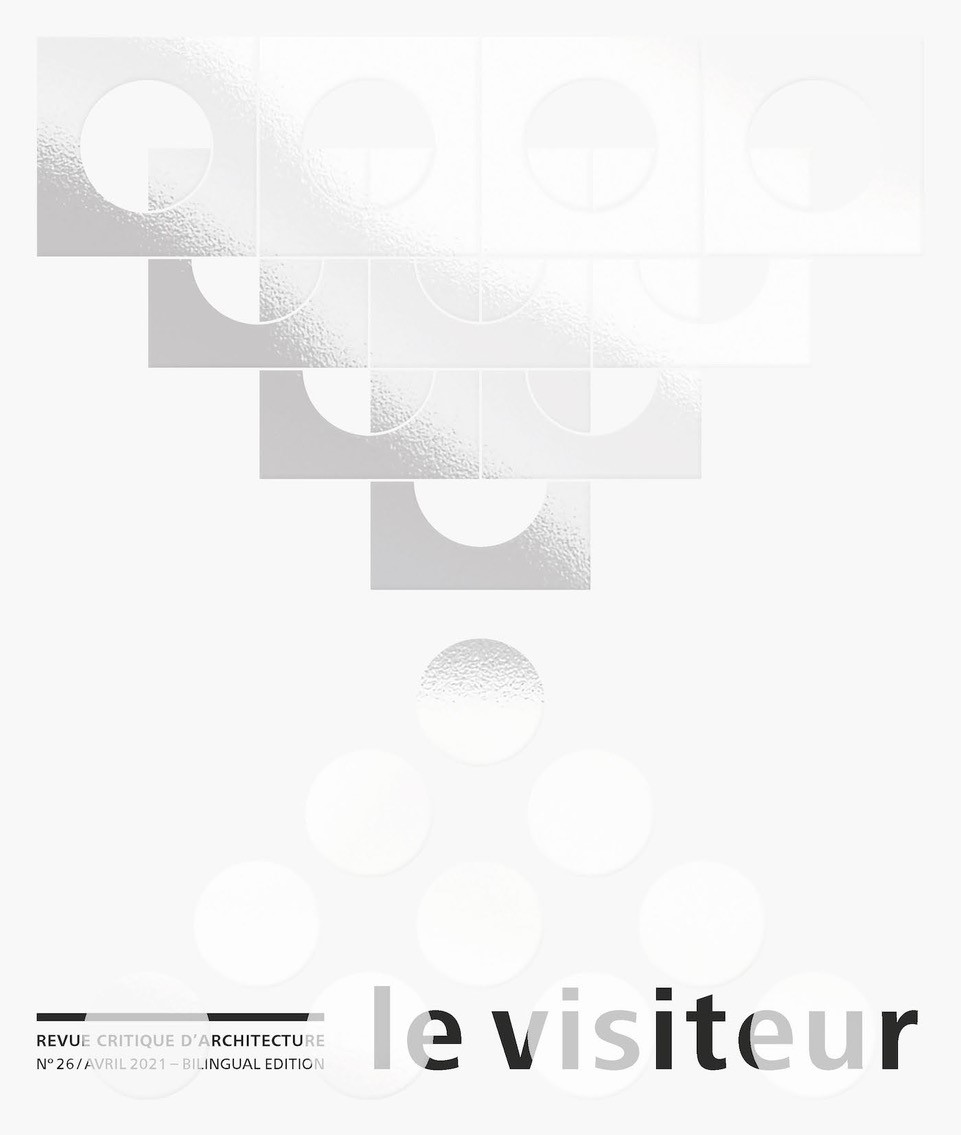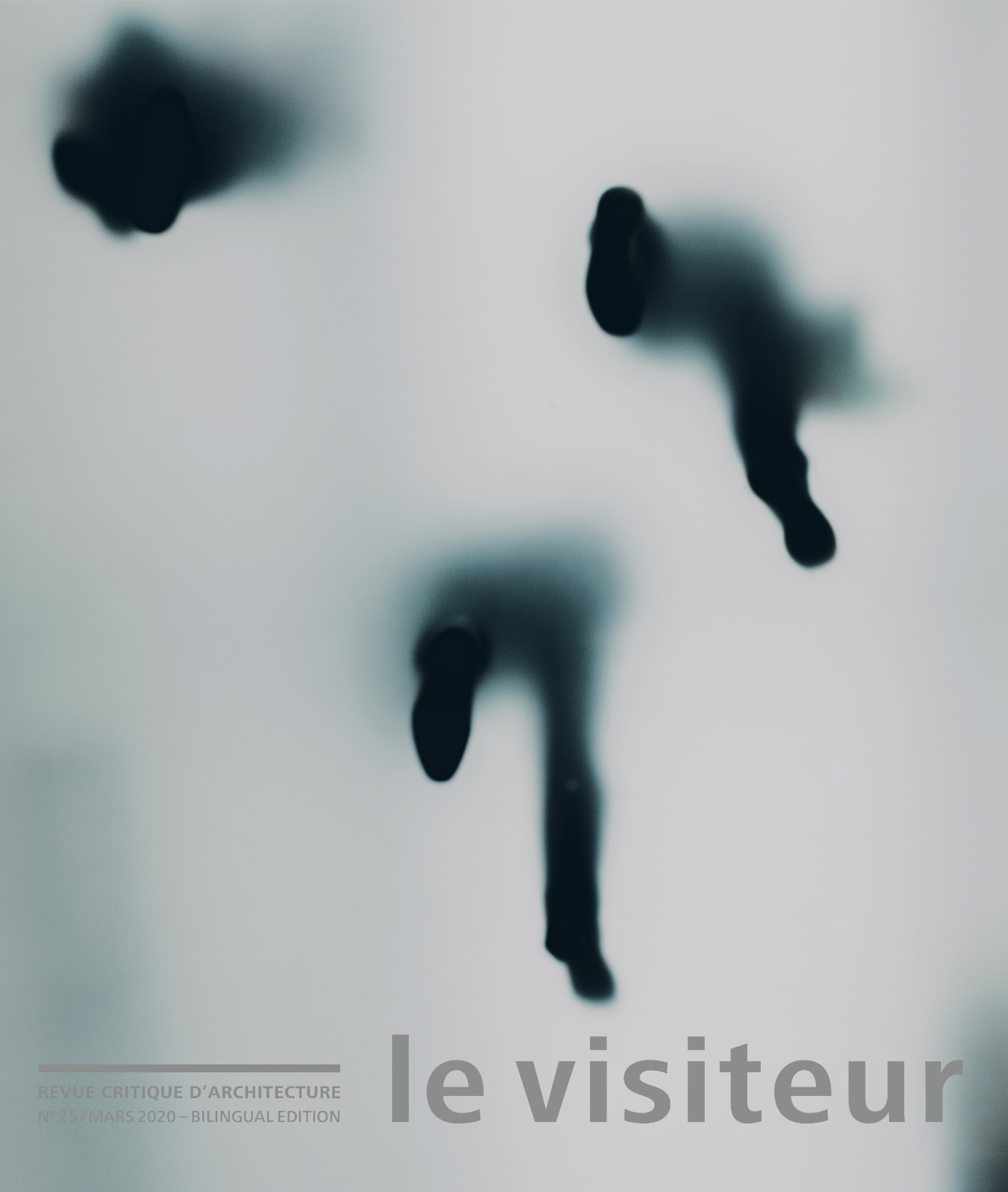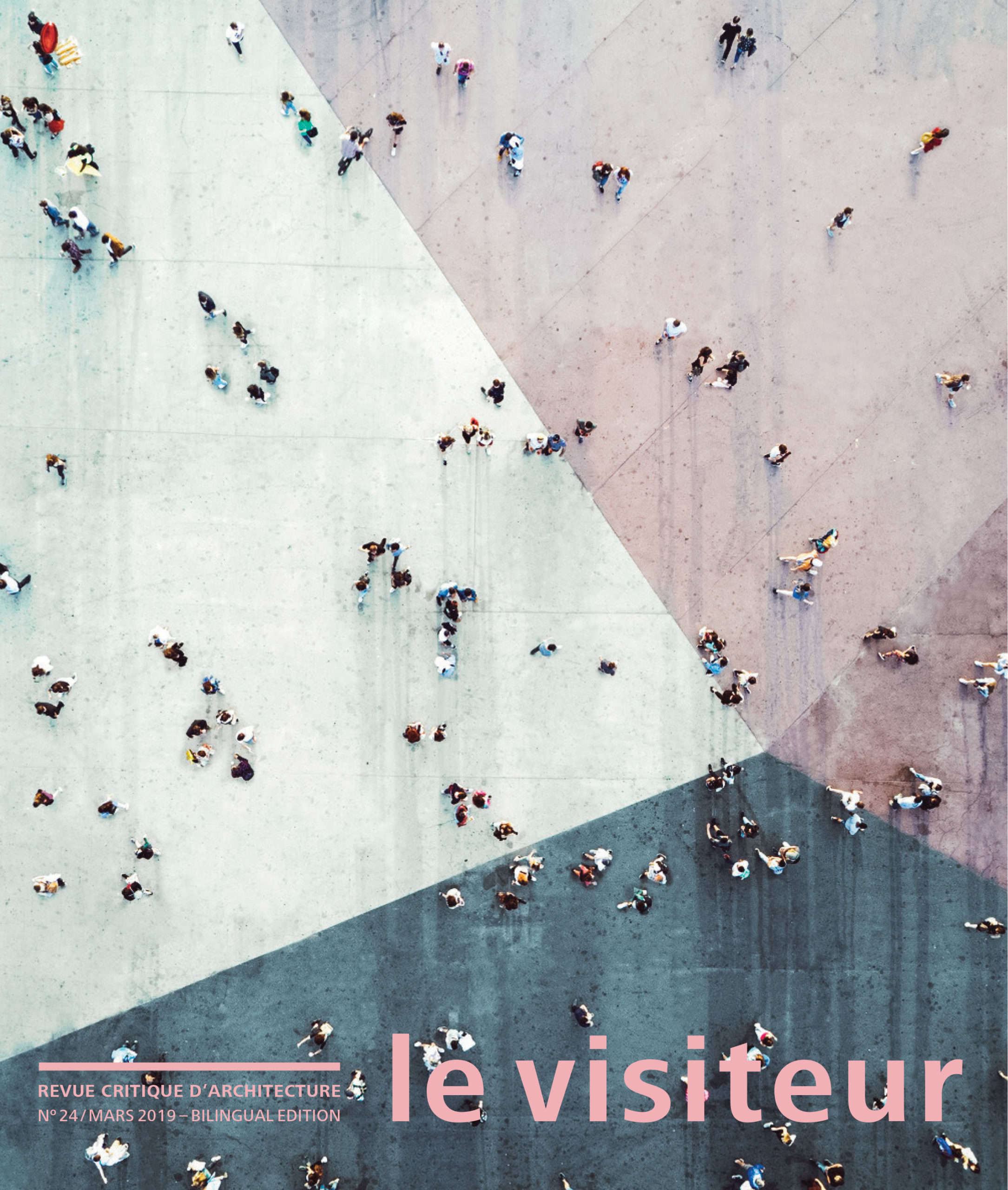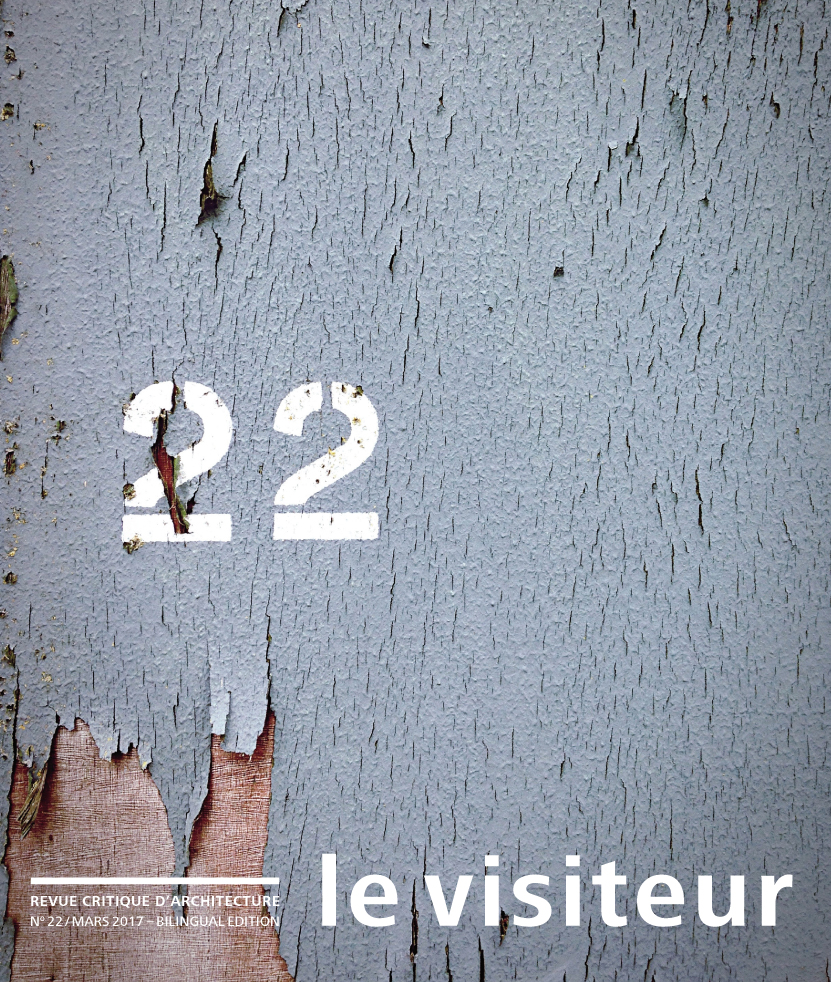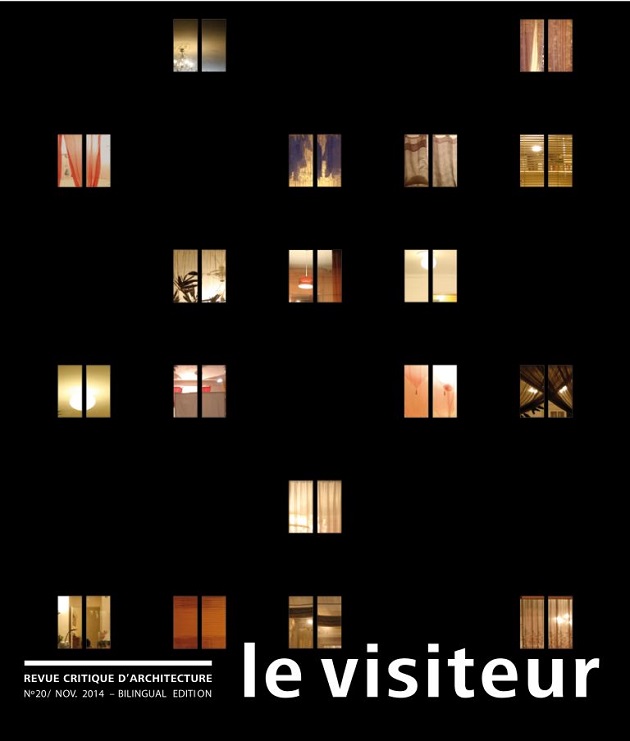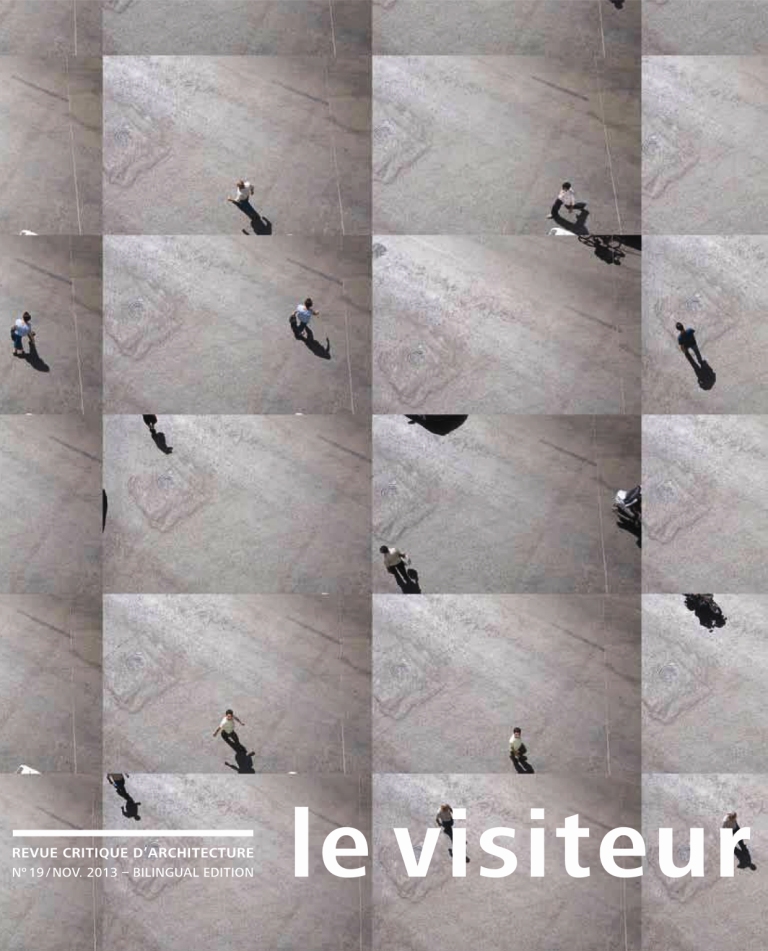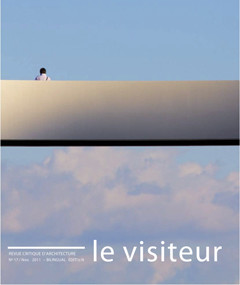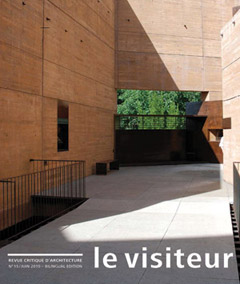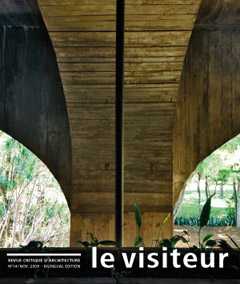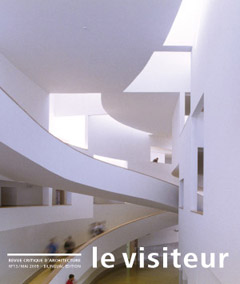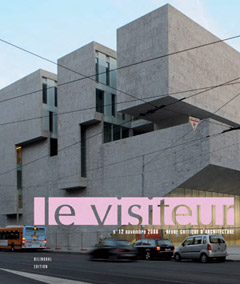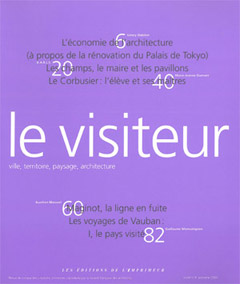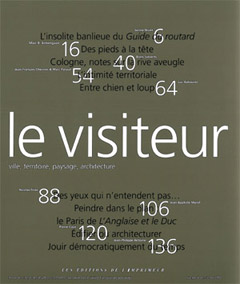Description
Publication date: 2014
Editorial: Memory and Time
Karim Basbous
Read moreThe following pages are devoted to time, the dimension where architecture, philosophy, and music overlap. However, the contents of this issue of Le Visiteur are far from metaphysical: rather, objects, cities, and memory are means for counteracting the abstraction of time, making it possible to observe it through that which somehow deforms and thereby reveals it. On the scale of an hour or a century, time – as revealed through that which has witnessed its passage – appears at times compressed, at others splintered or slowed. The passing of time can appear continuous or intermittently signposted with significant events. Time appears to be symmetrical with space: one immediately springs to mind alongside the other, and it is impossible to think of space without including time. The great ages of architecture and urbanism have always developed a specific relationship with time: the Renaissance embraced a historical point of view, using antiquity to invent the present, while schools of fine arts placed the principles of imitation and repetition at the heart of their teaching practice. The avant-gardes and the modernist movement were based on a break with the past and a dynamics of the new. The very notion of the “project” – the anticipation of a given reality – is temporal in essence. In contemporary architecture, the question that must be asked is that of the place of history, and more broadly, the meaning of legacy. In short, time has several territories, several cards in play, which the authors of the following articles were given carte blanche to explore.[1]
My own contribution challenges the notion of “dismantling” the box, commonly associated with modern architectural doctrine, focusing on (equally modern) buildings where the movements of the body and the gaze internalise the pleasure of space by means of the multiplication of situations. It explores how the plans in question “open inwards”, so to speak. This is not unconnected with the priciple of “spatial dilation” that underpins the reason for design in the work of Henri Ciriani, which, as Pierre Caye demonstrates, is simultaneously a dilation of the moment. Caye’s article sets out to untangle the relationship between architecture and the world, production, and sovereignty. The ambition of Augustin Berque’s article is to explain the notion of space-time in Japanese poetry, focusing particularly on the haiku and the structures of Japanese as a language, thereby shedding light on a philosophy in which the perception of the world and the formation of things takes place outside the categories that long shaped how space and time were read in the West. Martin Bressani argues that the past of architecture is less what is behind us than that which returns to the world of the living, like a spectre; his article explores the interest and limits of considering the evolution of forms as a perpetual resurgence of what once was. The principle of resurgence is likewise a key notion in Philippe Potié’s exploration of the fate of mythical cities, which connects resurgence with the notion of the built-in, pre-planned death of the city. Erika Naginski’s work draws on ruins to shed light on the affinities between images by Piranesi and the philosophy of Giambattista Vico. The psychoanalyst and author Francis Hofstein’s contribution is a meditation on subjects ranging from art and architecture to religion and crime. Antoine Picon and Philip Ursprung explore the relationship between time and contemporary architecture, the former in terms of structure and ornament and the latter in terms of the “eternal present” evoked by current objects. Sarah Whiting’s article establishes a link between the contemporary cult of speed and the indecision hinted at by design tools with a plethora of functions and the inflation of images.
Two articles focus on one particular dimension of time: memory. The first, by Aurélien Lemonier, studies post-colonial Indian architecture, in which the continuity of practices, customs, and ideas in the light of the political dynamics of twentieth-century Indian history cannot simply be reduced to a stand-off between modern ideology and traditionalism. Jonathan Friedman’s extended article is devoted to the Yad Vashem memorial designed by Moshe Safdie – a building which snatches visitors out of ordinary time to place them in abstract time, “dismantled” by the architectural plan. The author’s account of his visit to the memorial reflects both the real – the hic et nunc – and the imaginary dimension inherent in all grand architectural experiences: the geometric order of the rooms becomes jumbled with the tumult of thoughts and emotions stirred by the journey through the space. Friedman reminds us that places, like texts, always call to mind fragments from elsewhere.
[1] The articles originated at the conference The Space of Time, organised by the Société Française des Architectes in collaboration with the CNRS and with the generous support of the Urbaine de travaux.
Translated from the French by Susan Pickford
The promenade dramatique at Yad Vashem
Jonathan Block Friedman
Read moreBuilt on the western outskirts of Jerusalem, architect Moshe Safdie’s Holocaust Museum exploits dramatic structural and spacial gymnastics to heighten our encounter with tragedy. While Safdie’s Prism springs its darkness on us in dramatic surprise the other parts of the site deliver an altogether different interpretation of the drama as it plays more on musical resonances and an algebraic order of modulated solids and voids.
The Cow and the Elephant
An Indian Lesson
Aurélien Lemonier
Read moreThe years following Indian Independence (1947) were a time of accelerating urbanization. There was a concern both to define new planning policies and to symbolically affirm the break with English colonization. The modern architecture favored by the prime minister Nehru on major national construction projects was one of the vectors of the new democracy. The construction of the new town of Chandigarh directed by Le Corbusier and Pierre Jeanneret would become especially invested with this symbolic function.
As of the mid-1960s a whole generation of architects distanced themselves from the doctrine of the Modernist movement in favor of greater concentration on the specificities of Indian society: the relation of the city to the natural environment, and that of architecture and its cultural imprint to the acceleration of the industrial economy. In doing so they called into question the traditional oppositions between modernity and tradition, high culture and vernacular culture, industry and artisanship.
Ultimately, what was going on behind the attempt to interpret and revisit Mogul architecture, undertaken by Raj Rewal and many other architects, was the process of constructing an identity, in parallel with the continuous circulation of ideas between East and West impelled and absorbed by India.
The monocle and the kaleidoscope
Karim Basbous
Read moreFor the past century, “dismantling the box” has been the leitmotiv consecrating the conquest of the exterior as one of the founding themes of architectural modernity. Yet many of the twentieth century’s most emblematic projects reveal a different principle that has remained in the shadow of theory. This is the principle of implosion, in which the centrifugal dynamic takes place within the building, in several “ignition sites” that echo the viewer’s gaze and integrate it as a counterpoint to the itinerary. This hypothesis arises from a question connected to our daily experience of space: do we only inhabit the place where we are, or also the places we see? Dissociating the two lived realities – physically occupied as opposed to visually perceived space – creates a means of distinguishing between two types of architecture: that which is content with its status as object and lets itself be viewed as a container or vase, and a more complex model in which the plan serves the Odyssey of the body and the gaze through a multiplicity of situations and an interweaving pattern of potential itineraries, associating the experience of inhabiting with the desire for the “as yet to come” foreseen and the memory of the past experienced. This architecture invents a kind of 3D labyrinth whose sight lines reconfigure its lines with every step, the point being, unlike in a traditional labyrinth, not to find the fastest way out but to fill in the time spent within.
Architecture, dilation, unproduction
Pierre Caye
Read moreThe concept of lasting development appears so uncertain and ill-grounded because it is understood from the wrong angle, giving development a duration, as if duration were a straightforward quality that can be added to development. However, time is not a substance or anything that can be determined and manipulated at will. The polarity of the expression “lasting development” should be reversed: not adding time and duration to development, but thinking more fundamentally about how our relationship with time is vital in understanding the form taken by our system of production. In the history of our material and technological civilisation, architecture helps us think about the shift from temporalisation to production better than any other human action or work. Architecture is the key mediator between time and production. Creating architecture consists of spacing, creating gaps, dilating. Space contributes to the construction of time, just as time contributes to the construction of space. This mutual construction of space and time is possible only thanks to the architectural mediation that makes it possible and which it is important to question as such. The essay thus demonstrates that this work of mediation is vital in understanding how, from the outset, architecture and architecturing have represented a genuine critique of production, thanks to which the notion of lasting development overcomes its contradictions and its aporias.
How (architectural) forms unfurl in space
Augustin Berque
Read moreCartesian dualism has congealed space into an freeze-framed object, abstracted from the movement of existence. Heidegger rejected this de-temporalisation of space, arguing on the contrary that the being of things begins with their material contours rather than being limited by them. Concrete shapes are a relational process in the process of unfurling rather than objects congealed in their own being-in-themselves. The first landscape theorist, Zong Bing (375-443), made this his principle: “As to landscapes, they exist in material substance and soar into the realm of the spirit”. This “soaring into” (qù) is what takes places between the physical and the phenomenal. Spatio-temporal unfurling is what institutes the object so that it can exist for the subject, as the sciences of nature themselves (both Heisenberg’s physics and Uexküll’s biology) came to acknowledge in the twentieth century. It was neither the object in itself nor the subject in itself, to which the modern alternative has been limited, but rather the “third kind” that Plato’s Timaeus recognised in the concrete milieu (chôra). This milieu where shapes unfurl concretely cannot be contemplated in terms of the twofold principle of identity and the excluded third that dominated Greek rationalism and later engendered modern dualism and mechanicism. Understanding this requires a meso-logic that allows for thirds, i.e. that which is both A and non-A, like the chôra, which is both the imprint and matrix for genesis (relative beings in the tangible world). It thus goes beyond the principle of identity, which is limited to the alternative between A and non-A. This movement began with life, which unfurled the biosphere by going beyond identity in itself to the physical planet. Modern mechanicism interrupted this by attempting to apply itself to architecture, for architecture, continuing this movement, can only exist through the spatio-temporal unfurling of its shapes beyond identity.
Time as Atmosphere: Toward a Spectropoetics of Architecture
Martin Bressani
Read moreArchitecture has traditionally invested territory with temporality by creating permanence. Thanks to their solid, enduring quality, the palaces, cathedrals, tombs, and other monumental buildings that have constituted the core of architecture were eternal dwellings, linking past to present. Even prior the French Revolution, however, such monuments became symbols of oppression, and with the advent of modernity their role as consolidators of collective memory was rejected. Architects subsequently sought not to perpetuate a tradition but to envisage a liberating future. And yet the heritage of the past inevitably weighs upon us – architects, like philosophers and scientists, can never escape their own historical horizon. How, then, does the past currently make itself present in architecture? How can a rootless architect fill the void, overcome the absence, express the mourning? There perhaps exists a poetics of the withering of time, allowing the past to reemerge in ghostly fashion, like a return of the repressed. I offer some reflections on this “ghosting” of history via architecture, placing particular emphasis on nineteenth-century revival movements. How did the past go from being an active, normative presence to a qualitative atmosphere, an emotionally charged presence that inhabits the present like a ghost? This article explores the spectral reapparition, or revenance, of the past.
Piranesi and the Image of Time
Erika Naginski
Read moreThis presentation takes as its subject Piranesi’s “architecturalized archaeology” in relation to those intellectual and aesthetic currents of the European Enlightenment that fostered admiration for ancient Roman engineering and monumentalism. Perhaps more than any other architect of his generation, Piranesi tied his etchings to the drama of historical time. Rejecting Greek sources outright, he staged the triumph of Roman originality and its Etruscan roots. His controversial stance finds echo in the works of philosophers such as Giambattista Vico, who underscored the multiple origins of culture, as well as of theoreticians such as Carlo Lodoli, who put forth a rationalist doctrine of architecture. At the heart of all this lies the question of what it means to construe the ruin in polemical terms. We will consider how the collaged mixture of fragments on which Piranesi’s architectural imaginary relies was configured specifically as a form of visual argumentation about ancient Rome, its inspired – as opposed to derivative – ethos, and, more broadly, the deeply temporalized nature of the creative process.
Time stops
Francis Hofstein
Read moreDoes taking your time mean having it? And isn’t having time, which is reassuring, running the risk of wasting it, and thus running out of it? In which case it would be advisable to place limits on it, inscribe it within a given duration, give it something to do. However, since time is a material of intangible reality whose understanding is essentially subjective, and since building is a way of challenging time, demanding the stoppage or suspension of time to inscribe a space, there is no guarantee that this use will prove satisfactory. The main thing is not to kill time, even if times are hard, but rather just to put it under house arrest, stop thinking about the Fates, and borrow the poets’ favorite road sign, “Slow under construction”.
Apocalypse and Architecture
Philippe Potié
Read moreThe Apocalypse marks both the end of time, the fall of the cursed city of Babylon, and the unveiling of heavenly Jerusalem, the ideal city. Drawing on this Biblical model, the disintegration of the city can be seen to constitute the temporal spring from which a new vision of the city will be resurgent (from resugere, to resuscitate). Everything points to the “staging of ruins” inaugurating a new project. Such a cycle, with mourning prefiguring rebirth, lends substance to a visionary dynamics of architecture.
The present article follows in the footsteps of Aldo Rossi, Peter Eisenman, and Le Corbusier in identifying the micro-executions and everyday apocalypses in which archetypes – visions of the future – die, are forgotten, and then resurface in the memory of images. This perspective sheds light on the “temporal” knot which plays out the ambiguous articulation between modernity, postmodernity, and contemporaneity. The apocalypse represents this temporal operation which conjugates the iconoclastic rationalism of modern purism and the delirium of postmodern iconophilia.
Structure, ornament and time
Strange vessels from elsewhere
Antoine Picon
Read moreStarting in the nineteenth century and the work of theoreticians like Viollet-le-Duc and Semper, part of the problem posed by the relation between architecture and time was translated in terms of elucidating the link between architecture and structure, or architecture and tectonics, It was structure and tectonics that inscribed architectural production in its period context. This relation between structure and tectonics, temporality and historicity, also rested on the reinterpretation of the question of the ruin as revealing the mark of time on the building. The ruin effectively helped bring to light certain essential articulations of the structure.
It is by no means fortuitous that the questioning of the structural approach by much contemporary digital architecture has been accompanied by a profound crisis in the relation to time and history. This essay discusses the links between architecture, structure and time articulated since the nineteenth century, analyzes the crisis, and considers possible ways of addressing it.
Accelerating Hesitation
Sarah Whiting
Read moreIf the 20th century was dominated by what one might call a textual logic, the 21st has already been characterized as a visual century, with the image replacing the word. We read less, but look more. Skimming and scanning have supplanted studying. Our ever increasing access to information has led many to substitute observations for ideas, branding for discrimination, icons for architecture. How has this paradigm shift – to a world without pause – affected architectural discourse? Rather than prematurely decrying the death of architectural theory, we need to focus on how we make judgments within this new contemporary context of our image culture. Paradoxically, within this high-speed environment, judgment today more than ever requires carefully curated hesitations.
The Crystal World: Theory of the Eternal Present
Philip Ursprung
Read moreIf theoreticians such as Michael Hardt and Antonio Negri are to be believed, the industrialized world is drawing close to a new chronotope: an “eternal present.” What connection can be made between this chronotope and architecture? Might architecture’s predilection for looped structures (the eternal return of the same), its interest in atmosphere and its attentiveness to “events” be explained by this chronotope?
If, in the 20th century, theoreticians adopted a static position in order to be able to apprehend an environment that was permanently moving, are they not now inverting their posture? And if this is now volatile and shifting, is that not because the world has ceased to be volatile and has crystallized?

